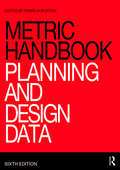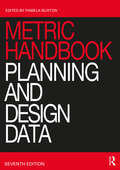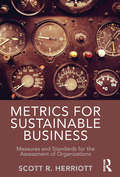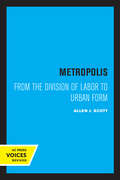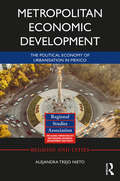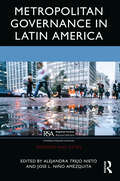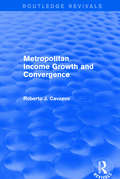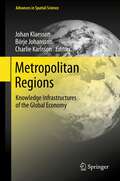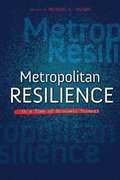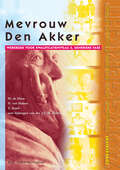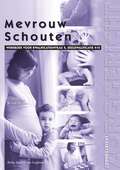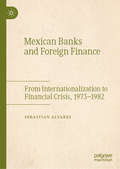- Table View
- List View
Metric Handbook: Planning and Design Data
by Pamela BuxtonSignificantly updated in reference to the latest construction standards and new building types Sustainable design integrated into chapters throughout Over half of the entire book has now been updated since 2015 Over 100,000 copies sold to successive generations of architects and designers This book belongs in every design office. The Metric Handbook is the major handbook of planning and design data for architects and architecture students. Covering basic design data for all the major building types it is the ideal starting point for any project. For each building type, the book gives the basic design requirements and all the principal dimensional data, and succinct guidance on how to use the information and what regulations the designer needs to be aware of. As well as buildings, the Metric Handbook deals with broader aspects of design such as materials, acoustics and lighting, and general design data on human dimensions and space requirements. The Metric Handbook is the unique reference for solving everyday planning problems.
Metric Handbook: Planning and Design Data
by Pamela BuxtonConsistently updated since 2015 by expert authors in the field Significantly revised in reference to changing building types and construction standards New chapters added on data centres and logistics facilities Sustainable design integrated into chapters throughout Over 100,000 copies sold to successive generations of architects and designers This book belongs in every design office. The Metric Handbook is the major handbook of planning and design data for architects and architecture students. Covering basic design data for all the major building types, it is the ideal starting point for any project. For each building type, the book gives the basic design requirements and all the principal dimensional data, and succinct guidance on how to use the information and what regulations the designer needs to be aware of. As well as buildings, the Metric Handbook deals with broader aspects of design such as materials, acoustics, and lighting, and general design data on human dimensions and space requirements. The Metric Handbook is the unique reference for solving everyday planning problems.
Metrics for Project Management: Formalized Approaches
by Ginger Levin PMP, DPA Parvis F. Rad PhD, PMPYour Complete Guide to Project Management Metrics is Here!Metrics for Project Management: A Formalized Approach describes a comprehensive set of project management metrics in an easy-to-read format. Through a unique presentation of metrics through the categories of "things," "people," and "enterprise," you'll learn how metrics can:• Guide you toward informed decisions• Help the enterprise recognize the sum of its collective capabilities• Ensure that plans for producing and delivering products and services are consistently realistic, achievable, and attainable• Link the efforts of individual team members with the overall success of the project• Indirectly promote teamwork and improve team morale
Metrics for Sustainable Business: Measures and Standards for the Assessment of Organizations
by Scott R. HerriottMetrics for Sustainable Business is the first book to give students a comprehensive understanding of sustainability in organizations from an accounting perspective. The book walks student through the steps for doing a sustainability assessment, and aims to develop them into financial analysts who understand sustainability reports, and are able to create or audit them. While most books focus on environmental issues, Herriott trains his gaze on the corporate and institutional perspective, covering measurement systems, how to evaluate and improve a standard, and conducting a life cycle assessment. Walking students through the programs of disclosure, the varying standards for corporate ratings, and organizational certification, allows them to grasp the tools for conducting a sustainability assessment and auditing reports. Chapters on accounting for greenhouse gas emissions, water use, and waste introduce students to the technical details in sustainability accounting, while a chapter on the philosophies of sustainability offers an answer to the question, "Why are they asking us to report that?" Richly demonstrated with practical examples and informative visuals, this book will serve students of sustainability, accounting, and integrated reporting.
Metro Cash & Carry
by Tarun Khanna Krishna G. PalepuAnalyzes the globalization of Metro Cash & Carry, a German wholesaler, which has flourished in many foreign markets but struggled to gain traction in India. Considers Metro's experience in Russia and China to put the company's challenges in India in comparative perspective. Pays particular attention to the institutional obstacles for a multinational to tap into the opportunities offered by emerging markets.
Metro-Goldwyn-Mayer (MGM) and Tom Cruise
by Anita Elberse Peter StoneIn November 2006, Harry Sloan, chairman and CEO of Metro-Goldwyn-Mayer Inc. (MGM) offers movie star Tom Cruise and his business partner Paula Wagner a chance to run United Artists (UA), a dormant studio within MGM's portfolio. Just over two months earlier, Viacom chairman Sumner Redstone publicly complained about Cruise's controversial behavior and abruptly ended Cruise and Wagner's 14-year relationship with Viacom's movie studio, Paramount Pictures. Sloan's proposal gives Cruise a chance to strike back. Can Cruise, Wagner, and Sloan, who regards the deal as an "interesting experiment" aimed at aligning the incentives of studios and creative talent, make the partnership work?
Metromedia Broadcasting Corp.
by Scott P. Mason Sally E. DurdanDescribes the market for high-yield, or "junk," bonds and includes summaries of academic research on the risk/return characteristics of high-yield securities. Describes the role of Drexel Burnham Lambert in the primary and secondary markets for high-yield debt. Decision focus is on a public offering of four high-yield securities issued by Metromedia Broadcasting Corporation in November 1984. The offering was used to refinance bank borrowings incurred in connection with Metromedia's June 1984 leveraged buyout. The securities offered included Serial Zero Coupon Notes due 1988-93, Senior Exchangeable Variable Rate Debentures due 1996, 15 5/8% Senior Subordinated Debentures due 1999, and Adjustable Rate Participating Subordinated Debentures due 2002. Proceeds from the offering totaled $1.2 billion.
Metropolis: From the Division of Labor to Urban Form
by Allen J. ScottHere is an extensive and highly original inquiry into the origins, dynamics, and internal order of the modern metropolis. Allen J. Scott demonstrates how the metropolis emerges out of the basic mechanisms of production and work in contemporary society, and how those mechanisms guide general patterns of urban development. His work will be stimulating to social scientists and to planners and policy makers as well. This title is part of UC Press's Voices Revived program, which commemorates University of California Press’s mission to seek out and cultivate the brightest minds and give them voice, reach, and impact. Drawing on a backlist dating to 1893, Voices Revived makes high-quality, peer-reviewed scholarship accessible once again using print-on-demand technology. This title was originally published in 1988.
Metropolitan Economic Development: The Political Economy of Urbanisation in Mexico (Regions and Cities)
by Alejandra Trejo NietoMetropolitan areas are home to a significant proportion of the world’s population and its economic output. Taking Mexico as a case study and weaving in comparisons from Latin America and developed countries, this book explores current trends and policy issues around urbanisation, metropolisation, economic development and city-region governance. Despite their fundamental economic relevance, the analysis and monitoring of metropolitan economies in Mexico and other countries in the Global South under a comparative perspective are relatively scarce. This volume contains empirical analysis based on comparative perspectives with relation to international experiences. It will be of interest to advanced students, researchers and policymakers in urban policy, urban economics, regional studies, economic geography and Latin American studies.
Metropolitan Governance in Latin America (Regions and Cities)
by Alejandra Trejo NietoThis book represents a powerful analysis of the challenges of metropolitan governance in all its messiness and complexity. It examines Latin American metropolitan governance by focusing on the issue of public service provision and comparatively examining five of the largest and most complex urban agglomerations in the region: Buenos Aires, Bogota, Lima, Mexico City and Santiago. The volume identifies and discusses the most pressing challenges associated with metropolitan coordination and the coverage, quality and financial sustainability of service delivery. It also reveals a number of spatial inequalities associated with inadequate provision, which may perpetuate poverty and other inequalities. Metropolitan Governance in Latin America will be valuable reading for advanced students, researchers and policymakers tackling themes of urban planning, spatial inequality, public service provision and Latin American urban development.
Metropolitan Income Growth and Convergence (Routledge Revivals Ser.)
by Roberto J. CavazosThis title was first published in 2001. What determines urban growth? Much has been written on particular causes and incidents which can explain the rise of one metropolis and the fall of another, but these do not illustrate general tendencies. This volume asks whether theories used to explain economic growth of nations or regions can be employed to find characteristics which encourage the growth of cities. Cavazos tests two principal theoretical approaches in this way. The first, the endogenous growth theory, predicts that incomes will diverge and sees technological innovations as the engine of economic growth. The second, the neoclassical growth theory, predicts conditional convergence and rates capital accumulation as the key to economic growth. He uses the two models to study US metropolitan income growth between 1970 and 1990 and compares their performance to determine which provides more insightful explanations of metropolitan growth.
Metropolitan Planning in Britain: A Comparative Study (Regions and Cities #19)
by Peter Roberts Kevin Thomas Gwyndaf WilliamsMetropolitan Planning in Britain is the first comparative analysis and assessment of metropolitan areas and their strategic planning for almost two decades. Changes in population distribution, styles of local government, business practices, and attitudes to the environment have all had an impact on cities in recent years which planners and other policy makers must take into consideration. Based on a series of research projects and the activities of a study group supported by the Regional Studies Association, the book examines in detail nine major urban areas, their specific characters and requirements, and how metropolitan planning is adapting to fulfil those requirements. It also discuses the possible future evolution of metropolitan planning, especially in the light of new regional arrangements and devolution.
Metropolitan Regions
by Charlie Karlsson Johan Klaesson Börje JohanssonMetropolitan growth has been dramatic in the past several decades, and today metropolitan regions are recognized as the main driving forces in national growth and development as well as in national and global innovation processes. The purpose of this book is to contribute to a better understanding of how metropolitan regions and their subsystems interact and compete, why they differ in their capacity to nurture innovation and growth, and how metropolitan policies must be designed to secure the region's long-term vitality. To that end, it presents new contributions on theories of urban growth, institutions and policies of urban change, and case studies of urban growth prepared by international experts.
Metropolitan Resilience in a Time of Economic Turmoil
by Michael A. PaganoCities, counties, school districts and other local governments have suffered a long-lasting period of fiscal challenges since the beginning of the Great Recession. Metropolitan governments continue to adjust to the "new normal" of sharply lower property values, consumer sales, and personal income. Contributors to this volume include elected officials, academics, key people in city administrations, and other nationally recognized experts who discuss solutions to the urban problems created by the Great Recession. Metropolitan Resilience in a Time of Economic Turmoil looks at the capacity of local governments to mobilize resources efficiently and effectively, as well as the overall effects of the long-term economic downturn on quality of life. Introducing the reader to the fiscal effects of the Great Recession on cities, the book examines the initial fraying and subsequent mending of the social safety net, the opportunities for pursuing economic development strategies, the challenges of inter-jurisdictional cooperation, and the legacy costs of pension liabilities and infrastructure decay. Contributors are Phil Ashton, Raphael Bostic, Richard Feiock, Rachel A. Gordon, Rebecca Hendrick, Geoffrey J.D. Hewings, David Merriman, Richard Nathan, Michael A. Pagano, Breeze Richardson, Annette Steinacker, Nik Theodore, Rachel Weber, and Margaret Weir.
Mevrouw Den Akker
by Y. Smid M. De Haan N. Van HalemHoofdpersoon in de casus is mevrouw Den Akker. Een oudere dame, die na een leven met haar echtgenoot, haar werk, de zorg voor de kinderen en allerlei activiteiten in de samenleving, nu in allerlei opzichten achteruit gaat en verzorgd moet worden. Een dame die je in menig verzorgingshuis zou kunnen tegenkomen. De specifieke zorg voor mevrouw Den Akker op het gebied van voeding en uitscheiding heeft in deze casus met het clusterthema "voeding en uitscheiding" speciaal de aandacht.
Mevrouw Schouten
by Nicolien Van Halem C. OttenZorgcategorie: Kraamvrouw Setting: KraamafdelingKorte inhoud: Bij de meeste vrouwen verlopen de zwangerschap, de bevalling en de kraamperiode zonder problemen, maar niet bij alle. Hanneke Schouten is zo'n vrouw. In de loop van de zwangerschap moet zij steeds meer rekening houden met gezondheidsproblemen. Een geplande thuisbevalling wordt verplaatst naar het ziekenhuis en ook de bevalling en de eerste uren daarna verlopen niet zonder problemen. Hierdoor is ook het kraambed anders en op een andere locatie dan Hanneke en haar man van tevoren bedacht hadden.
Mexican Banks and Foreign Finance: From Internationalization to Financial Crisis, 1973–1982
by Sebastian AlvarezThis book is one of the first historical revisions of the Latin American debt crisis of 1982, exploring recently disclosed archival sources for a number of creditor and debtor institutions. It fills a gap on the national and international historiography on international finance in the 1970s and the Latin American debt crisis of the 1980s. The domestic banking approach in revisiting the 1982 financial crisis is a main distinction of this work and the consequences of the involvement of Mexican banks in international finance a major contribution to the literature. Beyond its thoroughly international approach, the book addresses a broad array of disciplines: financial history, political economy, international relations and business history. While the focus is on financial crisis, its implications extend to current regulatory and financial policy relative to crisis and non-crisis matters. In addition to providing a template for understanding other instances of financial crisis, the book points the way to research in a wide range of additional questions. These include the economic role of foreign capital, the transmission of financial crisis, and the decision criteria of states during crises. It also offers a strong example of the importance of politics in resolving economic problems. Because of this, the book will be of interest to historians, economists and political scientists.
Mexican Consuls and Labor Organizing: Imperial Politics in the American Southwest
by Gilbert G. GonzálezChicano history, from the early decades of the twentieth century up to the present, cannot be explained without reference to the determined interventions of the Mexican government, asserts Gilbert G. González. In this pathfinding study, he offers convincing evidence that Mexico aimed at nothing less than developing a loyal and politically dependent emigrant community among Mexican Americans, which would serve and replicate Mexico's political and economic subordination to the United States.<P><P> González centers his study around four major agricultural workers' strikes in Depression-era California. Drawing on a wide variety of sources, he documents how Mexican consuls worked with U.S. growers to break the strikes, undermining militants within union ranks and, in one case, successfully setting up a grower-approved union. Moreover, González demonstrates that the Mexican government's intervention in the Chicano community did not end after the New Deal; rather, it continued as the Bracero Program of the 1940s and 1950s, as a patron of Chicano civil rights causes in the 1960s and 1970s, and as a prominent voice in the debates over NAFTA in the late 1980s and early 1990s.
Mexican Farmworkers in the United States
by Jonathan Schlefer Forest L. ReinhardtIndustry and Background Note
Mexican Multinationals: Building Multinationals in Emerging Markets
by Alvaro Cuervo-Cazurra Miguel A. MontoyaOver the past two decades, emerging market multinationals have become an important force in international business. This book provides a better understanding of the actions and strategies used by firms from mid-sized emerging markets to upgrade their capabilities and become successful multinationals. It is the first book to provide an in-depth look at Mexican multinationals, or 'Multimexicans'. These include some of the leading firms in the world, such as the construction materials producer Cemex and the tortilla maker Grumasa, as well as smaller but innovative firms such as the theme park Kidzania and the cinema multicomplex Cinepolis. This comprehensive analysis contains case studies written by local industry experts on these and other firms, across twenty-two industries. The lessons drawn will be of interest to researchers, students, and consultants, as well as managers and executives of firms in other emerging markets looking to upgrade capabilities and expand abroad.
Mexican Women in American Factories: Free Trade and Exploitation on the Border
by Carolyn TuttlePrior to the millennium, economists and policy makers argued that free trade between the United States and Mexico would benefit both Americans and Mexicans. They believed that NAFTA would be a “win-win” proposition that would offer U. S. companies new markets for their products and Mexicans the hope of living in a more developed country with the modern conveniences of wealthier nations. Blending rigorous economic and statistical analysis with concern for the people affected, Mexican Women in American Factories offers the first assessment of whether NAFTA has fulfilled these expectations by examining its socioeconomic impact on workers in a Mexican border town. Carolyn Tuttle led a group that interviewed 620 women maquila workers in Nogales, Sonora, Mexico. The responses from this representative sample refute many of the hopeful predictions made by scholars before NAFTA and reveal instead that little has improved for maquila workers. The women’s stories make it plain that free trade has created more low-paying jobs in sweatshops where workers are exploited. Families of maquila workers live in one- or two-room houses with no running water, no drainage, and no heat. The multinational companies who operate the maquilas consistently break Mexican labor laws by requiring women to work more than nine hours a day, six days a week, without medical benefits, while the minimum wage they pay workers is insufficient to feed their families. These findings will make a crucial contribution to debates over free trade, CAFTA, and the impact of globalization.
Mexican Workers and American Dreams: Immigration, Repatriation, and California Farm Labor, 1900-1939 (Class And Culture)
by Camille Guerin-GonzalesIn the first forty years of this century, over one million Mexican immigrants moved to the United States, attracted by the prospect of farm work in California. They became workers in industrial agriculture --barely recognized, never respected, and poorly paid. Native white American workers did not resent the Mexicans during prosperous times, when everyone who wanted to work could do so. But during the Great Depression, native workers began to realize that many of the Mexican workers were here to stay. <p><p> Native workers, blaming their unemployment on the immigrants, joined with government officials to demand that Mexican workers and their families return to Mexico. During the 1930s, the federal government and county relief agencies cooperated in a nasty repatriation program, forcing half a million Mexicans living in the U.S. to return to Mexico. <p> Camille Guerin-Gonzales tells the story of their migration, their years here, and of the repatriation program--one of the largest mass removal operations ever sanctioned by the U.S. government. She documents both their efforts to resist and the overpowering forces that worked against them.
Mexico (C): Reform and Crisis--1987-95
by Huw PillDescribes the evolution of the Mexican economy and its relation with the international capital markets in the period leading up to the Peso crisis of December 1994. Emphasizes the role of "Washington consensus" policies in stimulating the inflows, and the inability of the Mexican banking system to intermediate them efficiently.
Mexico - Culture Smart!
by Guy MavorCulture Smart! provides essential information on attitudes, beliefs and behavior in different countries, ensuring that you arrive at your destination aware of basic manners, common courtesies, and sensitive issues. These concise guides tell you what to expect, how to behave, and how to establish a rapport with your hosts. This inside knowledge will enable you to steer clear of embarrassing gaffes and mistakes, feel confident in unfamiliar situations, and develop trust, friendships, and successful business relationships.Culture Smart! offers illuminating insights into the culture and society of a particular country. It will help you to turn your visit-whether on business or for pleasure-into a memorable and enriching experience. Contents include* customs, values, and traditions* historical, religious, and political background* life at home* leisure, social, and cultural life* eating and drinking* do's, don'ts, and taboos* business practices* communication, spoken and unspoken"Culture Smart has come to the rescue of hapless travellers." Sunday Times Travel"... the perfect introduction to the weird, wonderful and downright odd quirks and customs of various countries." Global Travel"...full of fascinating-as well as common-sense-tips to help you avoid embarrassing faux pas." Observer"...as useful as they are entertaining." Easyjet Magazine"...offer glimpses into the psyche of a faraway world." New York Times

